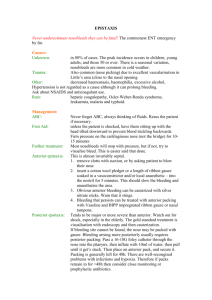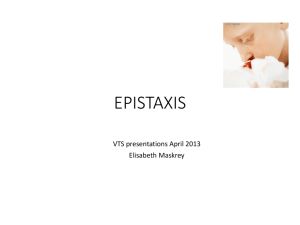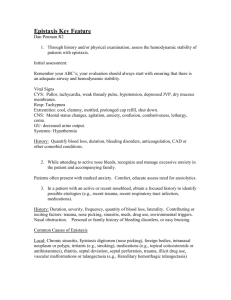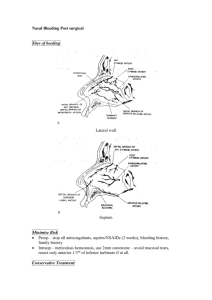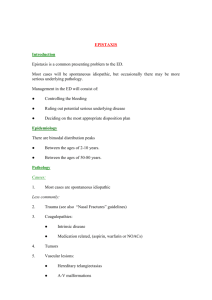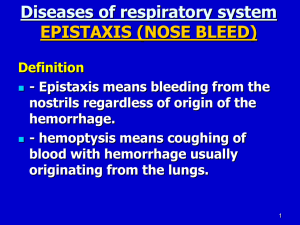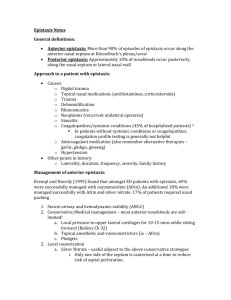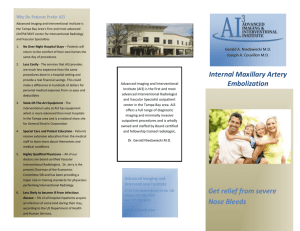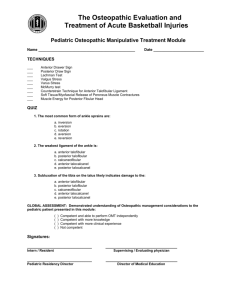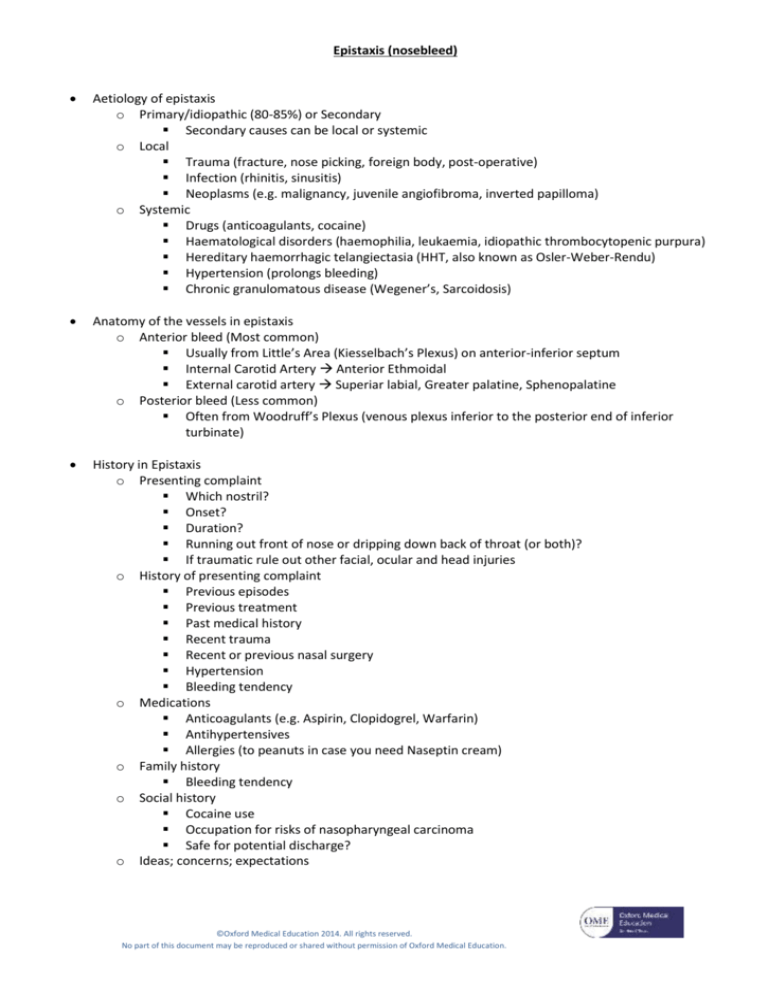
Epistaxis (nosebleed)
Aetiology of epistaxis
o Primary/idiopathic (80-85%) or Secondary
Secondary causes can be local or systemic
o Local
Trauma (fracture, nose picking, foreign body, post-operative)
Infection (rhinitis, sinusitis)
Neoplasms (e.g. malignancy, juvenile angiofibroma, inverted papilloma)
o Systemic
Drugs (anticoagulants, cocaine)
Haematological disorders (haemophilia, leukaemia, idiopathic thrombocytopenic purpura)
Hereditary haemorrhagic telangiectasia (HHT, also known as Osler-Weber-Rendu)
Hypertension (prolongs bleeding)
Chronic granulomatous disease (Wegener’s, Sarcoidosis)
Anatomy of the vessels in epistaxis
o Anterior bleed (Most common)
Usually from Little’s Area (Kiesselbach’s Plexus) on anterior-inferior septum
Internal Carotid Artery Anterior Ethmoidal
External carotid artery Superiar labial, Greater palatine, Sphenopalatine
o Posterior bleed (Less common)
Often from Woodruff’s Plexus (venous plexus inferior to the posterior end of inferior
turbinate)
History in Epistaxis
o Presenting complaint
Which nostril?
Onset?
Duration?
Running out front of nose or dripping down back of throat (or both)?
If traumatic rule out other facial, ocular and head injuries
o History of presenting complaint
Previous episodes
Previous treatment
Past medical history
Recent trauma
Recent or previous nasal surgery
Hypertension
Bleeding tendency
o Medications
Anticoagulants (e.g. Aspirin, Clopidogrel, Warfarin)
Antihypertensives
Allergies (to peanuts in case you need Naseptin cream)
o Family history
Bleeding tendency
o Social history
Cocaine use
Occupation for risks of nasopharyngeal carcinoma
Safe for potential discharge?
o Ideas; concerns; expectations
©Oxford Medical Education 2014. All rights reserved.
No part of this document may be reproduced or shared without permission of Oxford Medical Education.
Examination of epistaxis
o Do not underestimate as epistaxis can be fatal
o Remember personal protective equipment
o Airway, Breathing, Circulation
o Suction out large clots from nose
o Anterior rhinoscopy with Thudicum Speculum
o Oropharynx with tongue depressor for posterior bleeding
o Posterior rhinoscopy with Rigid Endoscope if necessary and able to do so
Initial investigation of epistaxis
o Full blood count
o Clotting
o Group and save (as a minimum)
Further investigation of epistaxis
o Identification of systemic causes if suspicious
Initial management of epistaxis
o Ensure airway not compromised by bleeding and not in shock (see shock section)
o Resuscitate if needed with IV access and fluids
o Consider reversal of anticoagulants depending on indication
o First aid
Sit patient forward, pinch soft fleshy part of nose, ice on forehead/back of neck, instruct to
spit blood into bowl as swallowing can cause nausea and vomiting.
o During this time ready Co-phenylcaine local anaesthetic spray (decongestant and vasoconstrictor),
suction, good light, nasal (Thudicum speculum), anterior packs (e.g. Merocel sponge, Rapid Rhino
hydrocolloid pack, Bismuth Iodoform Paraffin Paste (BIPP) impregnated ribbon gauze)
o After 15-20 minutes re-examine
o If bleeding stopped
Identify any target vessel for cautery using silver nitrate stick. You may see a clot, oozing
vessel, prominent vessel etc. Cauterise around target initially to stop feeding vessels then on
source itself. Rub Vaseline on top lip as otherwise can cause chemical burn and
discolouration from silver nitrate running down. Discharge home after observation.
Provide Naseptin cream (twice daily for 2 weeks) and avoid strenuous activity. ENT follow up
depending on local protocol.
o If bleeding continues
Anterior packing and admit. Ensure pack both sides for effective tamponade. Merocel/nasal
tampon requires lubrication with KY jelly and attaching a 0 silk if no string already attached.
Insert along floor of nose. Hydrate with 10ml water to expand. Rapid Rhino requires dipping
in water first, insertion, then expansion with a syringe.
o Provide analgesia +/- antibiotics depending on local protocol if packed.
Further management of epistaxis – call for ENT assistance:
o Posterior packing
Options depend on local equipment but include Foley Catheter (unlicensed use), Brighton
Balloon, posterior Rapid Rhino, Epistat, Formal posterior packing (rare) + anterior packing
with BIPP impregnated ribbon gauze if not available as part of posterior pack.
o Surgical treatment
Endoscopic Sphenopalatine artery ligation; Anterior Ethmoidal artery ligation; Maxillary
artery ligation; External Carotid artery ligation; Interventional radiology; Laser treatment of
HHT
©Oxford Medical Education 2014. All rights reserved.
No part of this document may be reproduced or shared without permission of Oxford Medical Education.
Common questions concerning epistaxis
o HHT/Osler-Weber-Rendu
Recognised by telangiectasia on lips and tongue.
Do not pack as can cause more bleeding.
Kaltostat or adrenaline soaked gelatine sponge if necessary.
o Cauterisation
Do NOT cauterise both sides as you will cause a septal perforation.
Likewise excessive cauterisation unilaterally is also a risk.
©Oxford Medical Education 2014. All rights reserved.
No part of this document may be reproduced or shared without permission of Oxford Medical Education.

